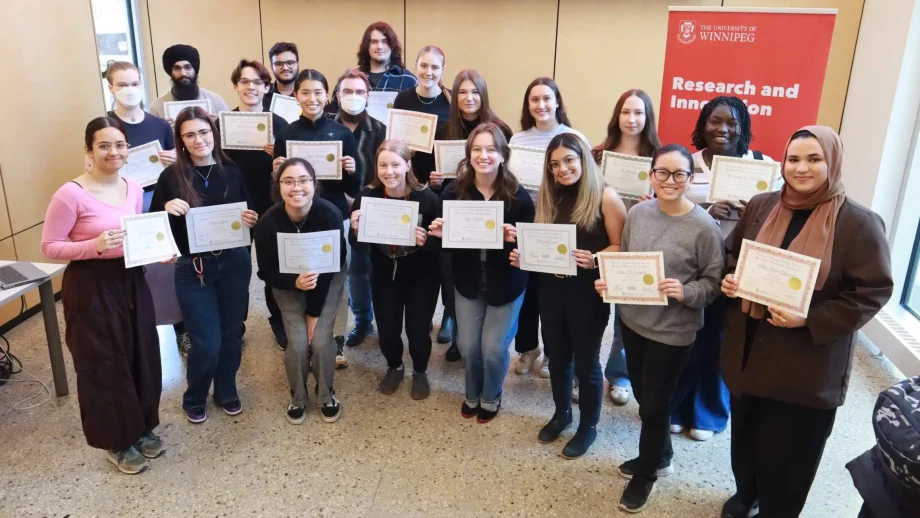
UWinnipeg’s resident batman, biologist Dr. Craig Willis (right), with post-doctoral fellows, Dr. Lisa Warnecke and Dr. James Turner
WINNIPEG, MB – The University of Winnipeg’s resident batman, biologist Dr. Craig Willis, with post-doctoral fellows, Dr. Lisa Warnecke and Dr. James Turner, and a team of international researchers have just published new findings on the infectious fungal disease white-nose syndrome (WNS) that is killing bats at an alarming rate. Their paper, Pathophysiology of white-nose syndrome in bats: a mechanistic model linking wing damage to mortality was published today in the prominent Royal Society journal Biology Letters. These new findings could help biologists respond to WNS, which is one of the most urgent challenges for wildlife conservationists in North America.
In addition to the UWinnipeg researchers, the transnational team included Dr. Trent Bollinger and Dr. Vikram Misra from the Western College of Veterinary Medicine, Dr. Paul Cryan and Dr. David Blehert from the U.S. Geological Survey and Dr. Gudrun Wibbelt from the Leibniz Institute of Zoo and Wildlife Research in Germany.
“We’ve known for a while that bats with WNS warm up too often during hibernation and burn through their fat reserves too quickly but we haven’t understood how a simple fungal skin infection could cause this,” said Willis. “Our new data show that bats with the fungus suffer from electrolyte depletion and other effects of severe dehydration and poor circulation, and the worse the damage to their wings, the worse these effects.”
The new data helped the team come up with the first mechanistic model connecting the skin infection to a range of physiological changes observed in sick bats. “In our model, fluid and electrolytes essentially leak from the skin lesions caused by the fungus and the resulting depletion causes thirsty bats to warm up too often to drink,” Willis explained. “The bats can access water in their caves but have no access to electrolytes until food is available in spring, which means their blood gradually becomes diluted over the winter. This would be bad enough on its own but the severe fluid loss may also hinder circulation — leading to a cascade of effects which further increase warm-up frequency and, ultimately, lead to mortality.”
Understanding the mechanisms underlying WNS is critical for responding to the disease and could help conservationists help bats. “In addition to providing more hints about what is actually happening to bats with WNS, the results suggest one intervention that could help more individuals survive until spring,” said Willis. “Providing a solution of therapeutic electrolytes that bats could access in a cave throughout hibernation might help. This isn’t going to cure WNS but might extend the life of infected bats. We hope to test the idea in The University of Winnipeg’s new Campus Wildlife Laboratory for Disease and Ecology (C-WiLDE) this winter.”
About WNS
WNS was discovered in 2006; it has spread rapidly throughout eastern North America and is now widespread in eastern Ontario, Quebec, Nova Scotia and New Brunswick. The disease is named for a white fungus (called Geomyces destructans) which invades the exposed skin of the muzzles and wings of the bats. Little brown bats, historically one of the most common North American species, are the hardest hit and current estimates predict local extinction for this species within 20 years of the arrival of WNS in an area. As a result, this species, along with two others, have been recommended for endangered status by the Committee on the Status of Endangered Wildlife in Canada; a listing decision is pending from the federal Environment Minister. WNS is a crisis for bat conservation but may also have wider consequences for ecosystems, forestry, and agriculture, given the role of bats as the primary consumers of night-flying insects. One recent estimate suggests that bats, in general, are worth billions of dollars annually for North American agriculture because of reduced crop damage and pesticide costs.
Biology Letters publishes short, highly-innovative, cutting-edge research articles and opinion pieces accessible to scientists from across the biological sciences. This Royal Society journal is characterised by stringent peer-review, rapid publication and broad dissemination of succinct high-quality research communications. To view the publication visit http://rsbl.royalsocietypublishing.org/.




